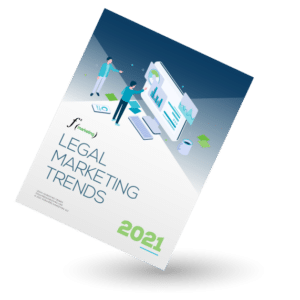In summer 2023, the world had high hopes for Meta’s newest social media platform, Threads. At a time when it looked like Elon Musk’s overnight rebrand from Twitter to X would contribute to the...
June 25, 2024
LEGAL MARKETING TRENDS 2021
Top Trends for Law Firm Marketing in 2021 and Beyond
Every year, we reach out to a select group of experts in legal marketing, business development, and tech to ask them for their thoughts on the most important trends shaping our industry. What comes next for law firm marketing? Read on to find out.
Download a PDF of the 2021 Legal Marketing Trends
Introduction: Lessons Learned
Few could have predicted the events of 2020. While numerous scientists and journalists warned about the possibility of a highly-contagious airborne virus jumping species to infect humans— and in 2019 the U.S. government conducted a simulation of such a scenario called “Crimson Contagion”—the Covid-19 pandemic still caught governments and businesses around the world by surprise. Law firms were no exception, although most recovered quickly after the initial shock, adjusting their operations with admirable alacrity.
This past year, our shared pandemic year, would seem to argue against the possibility of predicting the next few weeks, let alone the next 12-months. Yet, many of the legal marketing trends submitted by contributors in January of 2020 still held true, despite the extraordinary circumstances. That’s because these trends were grounded in sound marketing fundamentals and good business sense.
What do our contributing experts see on the horizon for 2021? In many ways, the pandemic has accelerated trends already underway, jolting even reluctant firms into adopting new methods, platforms, and technologies.
Many contributors point to the ever-increasing prominence of digital in law firm marketing. Katie O’Rouke notes that many firms have embraced webinars and video for virtual events, and she expects to see a digital component to in-person events and conferences, even once it’s safe to resume face-to-face meetings. Jaime Lira predicts an uptick in digital advertising, including Local Service Ads, a new product offering from Google. In SEO news, Callum Scott notes that Google rolled out a December 2020 update to their algorithm and has announced a forthcoming new ranking signal with implications for law firm websites. In her piece, Jennifer Whittier sagely speaks to the importance of having clean, accessible contact data for law firms eager to provide timely updates to clients and position themselves as thought leaders.
With the accelerating rise of digital, law firms and marketing professionals need to ensure that their content and platforms are made accessible to everyone, including people with visual or hearing impairments. As Lynn Foley notes, while the Trump administration placed web accessibility on a list of “Inactive Actions” in 2017 it appears likely that, under the Biden administration, the Department of Justice will define web accessibility requirements under the Americans with Disabilities Act (ADA).
Just as many contributors describe vital cultural shifts in the legal industry. 2020 sparked long-overdue conversations about systemic racial injustice. Gia Altreche notes that “2020 was a year that showed progress by moving conversation into action” and predicts that legal marketers “will play a key role in aligning, leveraging, and deepening DEI [diversity, equity, and inclusion] efforts within their departments.” Joanna Lane describes how Chambers and Partners continues to prioritize diversity and inclusion, both in the research process, through events, and internally.
Navigating this past year has not been easy and many firms have needed to reconsider or consult their crisis communications strategies. Traci Stuart offers some invaluable fire-fighting advice in her contribution. Also reflecting back to look ahead, Jennifer Evans considers how 2020 will impact the legal marketing hiring forecast in 2021.
2020 was a difficult year, “a slog” to borrow Traci Stuart’s apt assessment. There is no denying the toll the pandemic has taken on our industry and profession; Nearly 80% of respondents to our 2020 Legal Marketing Wellness Survey said that their work-related stress increased during the pandemic. Yet it’s possible to discern a glimmer of a silver-lining: legal marketers have shown themselves to be resilient, creative, and capable of rising to extraordinary challenges. And law firms have become increasingly open to innovative thinking. There is cause for hope in the year ahead.
The Trends
- Digital Experiences, Video, & Virtual Events, Katie O’Rourke
- Diversity, Equity and Inclusion (DEI), Gia Altreche
- Digital & Social Media Advertising, Jaime Lira
- Chambers and Partners: Diversity & Inclusion, Joanna Lane
- CRM Strategies, Jennifer Whittier
- Digital Accessibility, Lynn Foley
- Hiring Forecast for Legal Marketing, Jennifer Evans
- SEO: Google Search Updates, Callum Scott
- Crisis Communications, Traci Stuart
Firms Craft Digital Experiences to Overcome Covid-19 Constraints
By Katie O’Rourke, Regional Vice President, Sales, ON24 Inc.
For many marketing teams in 2020, the transition from in-person events – seminars, conferences, CLE training and other programs – to digital equivalents has been challenging. But this year, more companies than ever embraced digital technology.
While many pivoted to digital, the question was posed, “are we reaching digital fatigue?” The answer was no. In the ON24 Benchmarks Report Special Edition (which measured activity on the ON24 Digital Experience Platform in April 2020), we found that audiences craved webinars even more, consuming 295% more webinar content than the 2019 daily average.
Another interesting trend that came out of the report was the increased use of video for virtual events. Prior to the pandemic, there was a mix of video using basic webcam or on the other end of the spectrum, full production video. In 2020, as many people were quarantined at home and unable to do full studio production, video surged. Video became more accessible, no longer were you looking for that perfect video product. Everyone was more empathetic and open to different circumstances, like not being in an office, a dog in the background, a toddler crying. In April, video use in live webinars was up to 55% from 38% in 2019.
The best modern marketers are focused on creating immersive digital experiences that actively engage their audiences—highly interactive experiences that surround attendees in content offers and calls to action. And through such engagement, marketers access the insights needed to guide people through their unique buying journeys. For example, if prospects download a piece of content, marketers should be measuring that. If they ask a question on a live experience, that should be measured. That sort of engagement in turn provides unprecedented insights for marketers. Turning that engagement into action is the next step.
While we all would love to get back to in-person events and conferences when it’s safe to do so, we have also seen how digital events can complement in-person conferences and seminars. A hybrid event model can offer the best of both worlds: the networking, social opportunities and exciting mainstage content of an in-person event, complemented by the on-demand content and digital engagement that can follow the event indefinitely. Audiences now expect a digital component, and marketers are able to gather more tangible, actionable data than ever before.

Katie O’Rourke
Regional Vice President, Sales
ON24 Inc.
Purposeful Action Through the DEI Lens
By Gia Altreche, Director, Business Development & Marketing, Newmeyer Dillion LLP
With the in-your-face racial and social unrest and its pandemic counterpart, diversity, equity and inclusion (DEI) took a necessary priority seat at the (legal) table. 2020 was a year that showed progress by moving conversation into action, resulting in both internal and external demonstrations –allocation of additional internal resources, external statements and community donations – raising awareness and claiming stake in the active process of being a part of the solution. As law firms continue to build meaningful DEI business goals, legal marketers will play a key role in aligning, leveraging, and deepening DEI efforts within their departments.
Aligning Law Firm DEI Goals with the Department
Experienced legal marketers understand aligning efforts with the firm’s strategic goals further strengthen and drive a successful outcome. DEI is no exception. As firms create an impactful DEI strategy, innovative legal marketing teams have begun to embark on this collaboration, pushing past simply looking at the composition of pitch teams to creating meaningful key performance indicators (KPIs) around the impact DEI has on brand management and revenue generation. There is much anticipation that additional firms looking to drive change and innovation will join the ranks, furthering impactful legal marketing strategies that collectively move this business imperative forward.
Leveraging Resources for Intentional Coaching & Support
Law firms continue to battle the lack of diversity among the equity ranks, with retention being a significant obstacle in keeping diverse talent. To address this challenge, firms have leveraged full-time coaches and additional resources to not only further the development of diverse talent, but also to intentionally educate those leading inclusive teams. This two-prong strategy more deeply examines the drivers of engagement, furthering necessary conditions like psychological meaningfulness, safety and availability. This business strategy offers law firms, and business development teams in particular, an in-depth understanding of unique needs and ways to retain top talent and is anticipated to continue this year and beyond.
Deepening Client (DEI) Engagement
Over the past several years, strategic law firms have focused on a client-centric engagement model to offer personalized service and yield more purposeful results – clearer understanding of client needs, and specific, actionable insight to deepen the client relationship. We anticipate the ‘one size fits one’ model is here to stay, with the anticipation of one critical layer – diversity, equity and inclusion. With in-house legal departments also advocating for DEI across the legal ecosystem, we have an opportunity to incorporate their voice to drive change in the industry. Leveraging client feedback interviews, strategy calls, and other touchpoints to understand their DEI goals and the impact on hiring and retaining outside legal counsel, can further develop stronger alliances to the client’s business and impact the collective bottom line.

Gia Altreche
Director, Business Development & Marketing
Newmeyer Dillion LLP
Plaintiff Marketers Focus on Digital Ads in 2021
By Jaime Lira, Marketing Director, Cohen & Malad, LLP
Does your strategic marketing plan for gaining new clients include digital and social media ads? If you answered ‘no’, there are a few things you should consider.
Over the past several years firms have shifted focus from organic SEO and social media posts to paid digital and social media ads. This is not to say that interest in organic rankings has gone by the wayside. However, as an example, firms saw decreased organic exposure and engagement on Facebook after the platform made changes to its algorithm for business pages. This made having a paid presence essential in reaching new clients.
Social Media Ads Offer More Insight on Consumer Behavior
Social media ads on Facebook, Instagram and Twitter offer detailed targeting and robust creative options, including video, for ad campaigns. This allows marketers to not only home in on specific geographic areas but also find potential clients with particular interests or behaviours to match up with ideal client personas. These social media platforms provide marketers with real-time data to analyze so that changes can be made to creative or copy on active campaigns. This is a significant advantage over traditional media like television and billboards as making changes to these campaigns takes more time and resources. These platforms are also effective remarketing tools and can serve up custom ads to people who have visited specific website pages.
Google Local Service Ads for Lawyers
Google was busy in 2020 beta-testing a new product called Local Services Ads. These ads are significantly different (pay per lead rather than pay per click) and are currently being offered to select industries and markets. Lawyers and law firms must complete an application with Google to participate in Local Services Advertising. Pricing is different than pay per click campaigns and has been fluid as Google continues to test this product.
Local Services Ads appear at the top of search results above pay per click ads and are highlighted as Google Guaranteed businesses thus giving businesses more credibility in the mind of the consumer. If these ads are not available in your market yet, you can still complete the application and be notified when they are launched.
Making the shift to include a paid presence on social media and digital advertising can help your firm gain visibility and clients. If you are new to having a paid presence, there are plenty of free online tutorials available or you can hire an agency. Cheers to connecting with more clients in 2021!

Jaime Lira
Marketing Director
Cohen & Malad, LLP
Chambers and Partners Continues to Prioritize Diversity & Inclusion
By Joanna Lane, Editor, Chambers Canada
There is without question an increasing focus on diversity and inclusion within the legal industry. At Chambers, D&I continues to be a key business priority and remains an important topic raised during our conversations with in-house counsel.
Last year, we started collecting diversity statistics as part of the submission process for the Canada guide and the Canada team continues to pay close attention to the work and accomplishments of female lawyers. While we have not published this information, it helps us to better understand the profession, provide context to our rankings and drive change. In the latest edition of Chambers Canada, there were 256 newly ranked lawyers, of which 88 were women.
We request this information as part of the submission process across all guides – while the focus is primarily on collecting data regarding gender, in certain jurisdictions we also request information relating to ethnic diversity, sexual orientation and disability.
Chambers has additionally introduced a leave policy covering all absent leave including but not limited to primary and secondary caregivers and leave of absence for health reasons. We encourage firms to declare this information in the relevant section of the submission form – this information will be treated sensitively and confidentially and will allow ranked individuals to retain their banded ranking for a set duration during the period of related absence.
All our research teams have undergone D&I training this year, and we have begun to incorporate diversity questions into our research interviews to develop our understanding of what measures firms are taking to address diversity within their organizations.
Since 2012, Chambers has hosted numerous diversity seminars and awards across North America, Europe, Asia Pacific and Latin America which include events in New York and Miami. This year, Canadian firms were featured for the first time as part of our North America Diversity & Inclusion awards, which were held virtually on September 24.
In private practice, our first Outstanding Firm for Furthering Diversity & Inclusion award was presented to Bereskin & Parr.
Our in-house individual award was received by Julia Shin Doi, General Counsel and Secretary of the Board of Governors and University Privacy Officer at Ryerson University, and our in-house company award was received by RioCanREIT.
Chambers is also committed to fostering and promoting an inclusive environment for our employees. We have a dedicated Diversity & Inclusion department with a D&I Director and D&I Advisor who work on all internal and external matters. We also have an INSPIRE committee which creates the foundation for our internal D&I network created to actively encourage an open, transparent and supportive workplace culture driven by the diversity of our people, our thoughts and our innovation thus enabling every employee to feel empowered in the workplace. The committee is composed of individuals across the business shaping and informing D&I at Chambers with a member of the Leadership Team acting as an Executive Sponsor for each of the following strands: Age & Disability, CSR, Cultural Inclusion, Environment & Sustainability, Gender, LGBT+, Mental Health & Wellbeing, Parents & Carers, and Social Mobility.
Read the Diversity & Inclusion statement from Chambers and Partners CEO Tim Noble.
CRM Trends: Building Blocks in 2021
By Jennifer Whittier, President, ContactEase
My message to legal marketers in 2021: You are doing a great job – keep it up and keep it simple!
Before we look forward, let’s first look back: 2020 taught us the importance of resilience. Last year, marketers worked closely with their firms’ lawyers to communicate with their clients about the ever-changing and uncertain landscape at a rapid pace. When COVID hit, firm clients needed access to information quickly and the firms able to provide updates were seen as leaders during this unprecedented time. As we enter 2021, this will be just as important
Marketers have long been adept at leading change, but 2020 saw lawyers, not often thought of as change agents, adapting quickly and nimbly (and surprisingly doing so quite well). With firms clamouring to get in front of clients and prospects, it became more important than ever to embrace tools such as CRM and marketing automation. For many firms, this meant evaluating the processes around their current CRM applications and quickly realizing they lacked adequate contact management firmwide.
Marketing has long advocated that firms approach CRM as a strategy and not just a platform. As firms strive to maintain the momentum of the last year, this will be especially important in 2021. Developing processes and procedures around CRM will ensure that what firms started in 2020 will meet the ongoing and changing needs of 2021 and beyond. Remembering the “R”elationship in CRM will be especially important going forward. Aligning client communication preferences and building out relationship profiles will ensure lawyers are communicating the right message, at the right time, to the right person.
We can expect to see expanded use of integrations to support this right-sizing of communication. CRM platforms that afford easy-to-use marketing automation will be the product of choice in 2021. For example, ContactEase officially became a HubSpot integration partner in late 2020. Choosing to integrate CRM with a tool like HubSpot, provides the marketer with readily accessible metrics and trend data. These enhancements allow you to quickly react and course adjust your messaging.
Look for vendors utilizing cutting-edge platforms to enhance contact management. Additionally, integrations with the financial system will help firms round out the client profile stored in the newly reimagined CRM. However, if lawyers can’t easily, effectively, and reliably manage their contacts, how much good can it really do? Providing lawyers with an understanding of how they can quickly communicate and measure their efforts will go a long way in obtaining their buy-in.
There are two easy things marketers can do to ensure successful outreach:
1. Plan: No matter a firm’s size, putting a data management plan into place will reap numerous benefits. Aligning firm contact data by industry and practice group, allowing for segmented outreach with measurable results, can be easily achieved with minimal lawyer effort. Look for tools that allow lawyers to provide ongoing feedback on when and how to include a firm client or prospect when promoting a webinar or sending a time-sensitive update.
2. Track: Speaking of engagement, integrating CRM marketing automation tools will provide marketers with the metrics needed to provide content that is relevant to contacts. By understanding open rates and clicks, knowing when contacts are engaging with content and when they are not, marketers can empower lawyers to continue to produce content that works. Circling back to lawyers with campaign results will showcase marketing efforts and motivate the lawyers to contribute frequently.
With lawyers reaping the benefits of the targeted and focused client communications of the last year, 2021 provides marketers with the opportunity to build a business case for CRM, reintroduce the need for targeted and strategic outreach, and increase engagement among lawyers and clients—furthering the strong relationships so many of us desire to have with clients.

Jennifer Whittier
President
ContactEase
The Perfect Storm is Brewing for Digital Accessibility
By Lynn Foley, CEO, fSquared Marketing
2021 is shaping up to be the year in which legal marketing embraces digital accessibility in a major way. I say, “digital accessibility” and not simply “web accessibility” because, as a community, we need to be looking at accessibility in the broadest possible sense. While some aspects of digital platforms are subject to regulatory requirements, such as websites, and others may be exempt, accessibility is about more than just risk avoidance: it is about inclusivity and corporate social responsibility.
There is a potential perfect storm of situations brewing in the coming year that fills me with hope in relation to digital accessibility while acknowledging that some colleagues may look on the same set of circumstances with more than a hint of dread.
The first is political. In the United States, the Trump administration had a decidedly hands-off approach to the enforcement of accessibility compliance within the bounds of the Americans with Disabilities Act (“ADA”), announcing early on that the Department of Justice (“DOJ”) would place enforcement to “inactive status”. Under the Biden administration we can expect a more aggressive enforcement approach, similar to that of the Obama administration. As a result of renewed enforcement, businesses should expect the DOJ to call for higher monetary damages and civil penalties and more burdensome remediation requirements. These should not be dismissed as toothless threats – at present, the ADA authorizes maximum penalties of $96,384.00 for a first violation and $192,768 for a subsequent violation!
In Canada, the Accessibility for Ontarians with Disabilities Act (“AODA”) enforcement of web accessibility at a WCAG ‘AA’ level came into effect on January 1, 2021. A corporation/organization that is guilty of non-compliance can be fined up to $100,000 per day while directors and officers of a corporation/organization that is guilty can be fined up to $50,000 per day.
Here at fSquared Marketing, we’ve seen a dramatic increase in our website clients and prospects asking for accessible websites. I’m hoping it’s because I’ve been spreading the good word on the benefits for our greater community over the past few years, but I’ll admit that this sudden uptick might have something to do with those fines.
The second circumstance in this perfect storm is, of course, COVID-19. As everything is going online out of necessity, and lawyers are starting to embrace digital and social in a big way, we need to remember to make our assets accessible. Not just websites but our other digital assets including social media (and everything we post there), videos, podcasts, etc.
It may seem onerous as the volumes increase, but it’s not that difficult to make your social media posts accessible. For example, include image descriptions so that screen-readers can describe an image for an individual who is blind. You also need to make sure that your video content has open or closed captioning which is essential for people who are deaf or hard-of-hearing, as it gives them access to the information provided in the video. If you’re the person who makes the decisions on the images you include on your posts, no matter the medium, remind yourself that disability representation matters and consider using photos that include disabled people for non-disability related posts.
Sometimes if you want to enjoy the sunshine, you have to weather the storm. Navigating these requirements isn’t going to be easy, but I believe that, ultimately, our industry will meet the challenges and embrace an inclusive mindset for our digital era.
2021 Legal Marketing and Business Development Hiring Forecast
By Jennifer Evans, Executive Legal Recruiter/Co-Founder, Access Talent Solutions, LLC
At the start of a new year, I am frequently asked what the future holds for legal hiring. This January, I’ve received more questions about how this past year, 2020, will impact hiring decisions.
2020 began with a strong sense of optimism and a historically low unemployment rate; then March came. Positions were put on hold, and discussions of furloughs and salary cuts became my daily conversations. Thankfully, conversations shifted as we progressed through the year, and most of AmLaw100 and AmLaw200 rehired furloughed staff and retained their BD headcount. As we headed into Q4, the majority of my Zoom calls were filled with clients reporting historical numbers and business development leaders stating they were busier than ever.
2020 provided a time of reflection; we all gained a better understanding of what was working and what wasn’t. As we head into 2021, the talk is now about upgrading talent and enhancing technology and services. Firms learned that regardless of the uncertainty that still lies ahead, they can survive and possibly thrive in a pandemic and post-pandemic world.
Marketing leadership has become better at influencing decisions by providing metrics and ROI measurements; this, combined with lawyers having a better understanding of how to utilize a high-functioning BD resource converging with amplified competition for legal services, is creating increased opportunities for the legal marketing/business development professional.
Law firms that will provide challenging projects, flexibility, and increased visibility will be at the forefront of retaining top talent in 2021. In return, firms will have a higher expectation from the BD professionals they hire. Legal marketing leaders who can influence and help navigate client conversations and structure of services will be in higher demand. In addition, we continue to see a focus on cross-functional hiring. We are having increased conversations about customized roles that intersect traditional business development with other functions: legal project management, diversity and inclusion, pricing, to name a few.
Investment in new business development technologies is also expected. With Partners forced to work from home, decision-makers experienced how the right tech dramatically impacts efficiencies and service delivery. Firm leadership that has been reluctant to open the pocketbook for new systems is now more receptive; we are already receiving requests to locate Marketing & Business Development Technology Managers.
Lastly, I believe the working from home model is here to stay. I expect a return to the office hybrid schedule where people will be working within the office part of the week and other days from home. Lack of productivity is no longer a reasonable argument; individuals have proven otherwise. Firms can provide highly desired flexibility improving their recruiting strategy and, in turn, freeing up space to hire revenue-producing attorneys or cut commercial real-estate expense, an upgrade to the bottom line.
2020 was a year of lessons; we learned we can be fluid and flexible. We learned that even in conservative law firms, rapid, unexpected change can produce strong results. This shift creates room for firm leadership to embrace new ideas quicker and capitalize on BD talent who are hungry to make an impact. 2021 is setting up to be an exciting time for the legal community and the business development/marketing professional.

Jennifer Evans
Executive Legal Recruiter/Co-Founder
Access Talent Solutions, LLC
May the Best Answer Win: What Updates to Google’s Search Algorithms Means for Law Firm SEO
By Callum Scott, Senior SEO Analyst, Marie Haynes Consulting Inc.
Heading into 2021 we are right off the heels of Google’s December Core Update and with the Core Web Vitals being introduced as ranking factors in the spring, it is shaping up to be a very exciting year for search!
Google Rolls out Their December 2020 Core Update
While we are still assessing this latest update, a theme is emerging – Google is getting significantly better at understanding what content is the best of its kind, and specifically, what content best answers the true intent of the searcher. This has been a pretty constant theme over the past few years.
For legal sites, this means that some of the “older” SEO techniques that we see on a lot of law firm sites, such as churning out new blog posts every week, and indiscriminate link building, will continue to have depreciated value. Focusing on traffic quality instead of quantity is the approach we would recommend.
By determining exactly what searchers are looking for with their legal queries, and then producing best of its kind content to answer that question, you will have satisfied visitors to your site, and by knowing what most likely brought a searcher to your page you can target your calls to action appropriately! At the end of the day, satisfied, high conversion rate page views are far more valuable to your firm than ranking for a top keyword, but not answering the searchers’ query.
Core Web Vitals: An Upcoming Google Ranking Signal
The introduction of the Core Web Vitals (CWV) metrics into the page experience algorithm will also be important for legal sites. These metrics look specifically at how well the user experiences the page on mobile. Does the page shift considerably while loading? How long does it take for the main content to appear?
We believe that the CWVs will be treated the same as the other page experience metrics, and act as a tiebreaker for who ranks higher when Google cannot determine which content is of better quality. The legal space is very competitive, so if your content is already top-notch, having better CWV scores than competitors could be the edge you need to secure those top spots! As a bonus, good scores on these metrics also naturally improve your mobile page experience for users, which again, should result in higher conversions.

Callum Scott
Senior SEO Analyst
Marie Haynes Consulting Inc.
Little Fires Everywhere: Crisis Communications in the Year 2021
By Traci Stuart, President and CEO, Blattel Communications
It’s 2021. (Really!) After the slog that was 2020, it’s a rare lawyer or law firm that doesn’t have a crisis communications pro on speed dial. In a fast-paced, information-soaked environment where perception can sour in minutes, clients and law firms can be greatly damaged by unchecked misinformation or mishandled responses to crises. The threats run the gamut, from national incidents to local conflagrations. In short, firms need to have – and know how to use – both a fire extinguisher and a fire truck.
Here’s a quick review of a few of the mini-crises law firms faced in the past 12 months alone:
- Targets of discrimination and harassment lawsuits by their own partners;
- Unseemly, public “business divorces” – whether from partners or clients;
- Accusations of/investigations into financial or ethical improprieties (throw in an “unprecedented” pandemic with PPP funds flowing and “anonymity” afforded by virtual operations, and this part of the list is robust!);
- Furloughs, layoffs and related employee communications leaks;
- Pointed questions about commitment to diversity, equity and inclusion; and
- Professionals behaving badly.
Little fires can grow, “jump the line” and get out-of-control in a hurry. This is why a prevention/preparation strategy needs to be paired with effective mitigation tools. What may seem trivial at first needs to be scrutinized closely from all angles – genuinely and sensitively.
Here are three key mini-crisis communications lessons from 2020 that legal marketers and their firms can take into 2021.
1. Think Inside Out
Law firms generally have many employees beyond the lawyers who maintain relationships with their clients, as well as service partners and vendors, among others. Every individual who touches the firm has the opportunity to be a supporter or a detractor – all are keepers of the brand. When a crisis hits, the ability to communicate with these stakeholders is critical – but the speed and sequence of your communications can be the difference between marshalling an effective response or fanning the flames.
The firm’s overarching policies and culture script should dictate the first few defensive moves. A firm that consistently articulates and actually lives its values (sharing the goals, the programs and the hits/misses broadly internally, and often) will also enjoy a more informed approach. Share clear, highly vetted coordinated messages both internally and externally – but always internally first.
2. A Picture is Worth a Thousand Words
This old cliché has never rung truer. Anyone with a smartphone has the potential to be a “gotcha” journalist, and the public’s ability and eagerness to hit “record” has never been more acute. “Central Park Karen” can attest, a viral video spreads more quickly than even the most well-produced corporate communications (and certainly faster than the legal team’s ability to respond). Critically, viral videos circulate so quickly that a game of “Whisper Down the Lane” occurs wherein any original context is lost and alternate interpretations often take the place of actual facts. To ignore this reality or downplay its possible effects is to play with matches and be willfully ignorant of the media environment we inhabit.
Out of context photos, videos and quotes often become on social media the de facto history reel of what occurred. Regardless of any attempts to explain, qualify or present the true and legal facts, this “visual evidence,” clickable on the internet and reviewable at will, becomes the basis for the viewer’s knowledge (belief) about what occurred. In a world where legacy communications “gatekeepers” and legacy “trusted” media outlets have been denuded, a much more thoughtful strategy is required.
Acknowledging the trap-laced environment we are in, preparation is key. Have the firm’s response to an unflattering viral video ready and waiting. (You are closely monitoring social channels, right?) Have the spokesperson trained. Is there a firm policy that applies, and if not, is one needed? Do table-top exercises around crises, train staff and attorneys rigorously and prepare for occasions when a personnel dismissal may be necessitated, working with your HR resources, of course.
3. Time Always Mattered, but Never More so than Now.
Plan for mini-crises in advance and revisit the plans routinely and in the face of newly emerging reputational threats. While marketers often lament the fact that firms like to “follow the herd,” this is one area where you’ll do well to keep an eye on the Joneses (or Jones Days) and discuss the “what ifs,” should you be faced with a potentially explosive issue.
A “We’re working on it” response no longer satisfies your audiences, including media, clients or the general public. While five years ago, “an investigation is underway” might have bought extra time for internal vetting; now, time is already up – especially if there’s video evidence. Thinking through the most likely reputational threats and potential responses ensures the legal/HR/communications teams have time to gather relevant data, evaluate the strength of the firm’s position or message, and internally socialize the firm crisis communications approach.
In a crisis, leadership is key. Based on the lessons of 2020, law firm marketers are well-positioned to take a leadership role in planning for a potential law firm reputational crisis.
Run fire drills, check the equipment and, as firefighters preach, know two exits out of every room.

Traci Stuart
President and CEO
Blattel Communications
Marketing Legal Services in 2021
2021 will be a year of taking the lessons learned during 2020 and perfecting our messaging, methods, and models. Firms will continue to advance into digital frontiers, with the confidence that comes from having access to actionable data and guidance from skilled marketing professionals.
Firms will also look inwards, reflecting on critical issues such as diversity and inclusion. While digital platforms and tech offer exciting opportunities, it’s the energy, enthusiasm, and ingenuity of people—and the strength of the relationships forged—that are the surest sources of success.
Thanks to all of the experts who shared their insights on legal marketing trends. From all of us here at fSquared Marketing, we wish you all the best in 2021 and beyond!
Are you looking to stay ahead of the curve? Get legal marketing insights straight to your inbox!
Have a legal marketing question you’d like answered or simply want to hear more about our services? Get in touch with our team today.
Download a PDF of the 2021 Legal Marketing Trends
Sign Up To Our Newsletter


